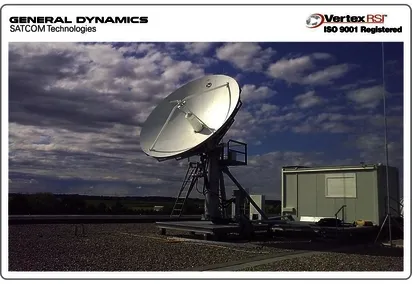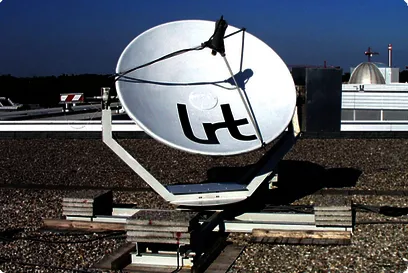Ground Stations
The first ground station of the Institute of Astronautics (IA) (S-band) and the Mission Control Center got operational in August 2006. This S-band antenna is constructed for the transmit and receive of satellite data from LEO and GEO, and thus encompasses the entire S-band frequency range (2.0 to 2.3 GHz).
The further and intensive research activities in the field "telepresence in space", especially through the project "LISA-MS" required the investment of an additional high-performance Ka-band antenna (20/30 GHz). These future orientated high-performance frequency band allows for high-data transfer, for example, image data in high definition quality. Especially for Earth controlled robotic missions a secure real-time transmission is important. The link configuration for such robotic missions are using a geostationary relay-satellite, to allow a longer contact time.
In the commercial area also draws from increased use of Ka-band technology to meet the demand of television broadcasts in HD quality.
Furthermore, this antenna is equipped with special measurement equipment to perform high-precision in-orbit measurements of communication satellites or acceptance tests from others ground stations. Because of these special measuring equipment of the IA Ka-band ground station, a research and development cooperation with the French satellite operator Eutelsat was created. After intensive series of tests the system was certified as a reference station for ESVA ( Earth Station Verification Acceptance ) - tests.
The UHF / VHF antenna was mainly realized for the TM/TC (Telemetry TeleCommand) operations of LEO satellites. In the past, the station was used for video downloads of the LAPAN TUBSAT mission. Since 2013, this antenna is used for the in-house CubeSat missions First-MOVE and MOVE-IIa/b.
For questions about specific antennas do not hesitate to contact us:
Nicolas Appel: n.appel(at)tum.de
Sabine Letschnik: s.letschnik [at] tum.de
Ka-Band Station

| Diameter: | 4.8 m |
| Antenna Type: | Cassegrain |
| Tracking Modes: | Step Track |
| Orbit Prop. | with TLE – NORAD & INTELSAT |
| EIRP: | 83 dBW (linearized TWTA) |
| G/T: | 33.6 dB/K (Inject Pilot System) |
| U/L Frequency Range: | 27.5 – 30.0 GHz |
| D/L Frequency Range: | 17.8 – 22.0 GHz |
| Polarizations: | H/V-LP & LHC, RHC (Tx, Rx) |
| Satellite Position Range: | 50°E to 80°W |
| Location: | Munich/Garching |
UHF/VHF-Station

| Antenna Type: | Yagi (VHF), Helix (UHF) |
| Tracking Modes: | Program Track |
| Orbit Prop. | with TLE – NORAD |
| EIRP: | 49 dBW linearized SSPA (UHF) |
| G/T: | -19 dB/K (VHF) |
| UHF Frequency Range: | 400 – 435 MHz |
| VHF Frequency Range: | 135 – 145 MHz |
| Polarizations: | LHC/RHC |
| Satellite Position Range: | Full Motion |
| Location: | Munich/Garching |